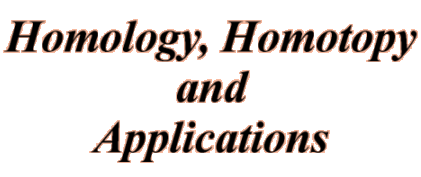

 |

|
|
INFORMATION FOR AUTHORS
Submissions are handled using EditFlow. Authors may select any of the editors on our Editorial Board, including the Managing Editors and the Executive Editor. All papers are refereed and acceptance of an article by an Editor indicates that the high standards of the journal have been met. For more information, see the page about the Editorial Process, noting that articles over 30 pages in HHA format (10pt computer modern font, textwidth 5.1in, textheight 7.8in) are rarely accepted. Tabular data, computer code, or other similar material not appropriate for print publication can be made available for download from the HHA website. If an article is accepted, the authors should prepare a final version using the journal class file hha.cls. (With some browsers, you may need to right-click and select an appropriate option.) The authors should carefully follow the style guidelines below. The references should be updated and the content of the article should only be changed as requested by the referee/editor. Authors should upload both the source .tex file and a pdf file to EditFlow. Articles are copyedited by professional copyeditors who may make additional stylistic changes, but it is the authors' responsibility to follow the guidelines. An article that is too difficult to work with will be sent back to the authors. At the time of acceptance, authors must submit a Consent to Publish form. Authors may choose to retain ownership of copyright to their work, subject to appropriate use of the work by the journal. Accepted papers will be made available online and will be printed by International Press. Each author will receive a complimentary copy of the issue in which their article appears. STYLE GUIDELINES This list is not exhaustive. Authors should use common mathematical style.
LaTeX:
The LaTeX class file hha.cls must be used.
Please look at the sample tex file
and the hhaguide.
You may also find it useful to run Language: Articles are accepted in English, French or German. If you are not fluent in the language of the article, it is recommended that you ask a colleague to proofread your article. The fewer language changes that our copyeditors need to make, the less likely it is that an error will be introduced. Metadata: Articles should include authors' names, addresses and e-mail addresses; AMS 2020 Mathematics Subject Classification; keywords; and an abstract of not more than 200 words. Please use the commands described in hhaguide to provide this information. The abstract should be self-contained and in particular should not cite references. It will be converted to html for the web site, so it is helpful if the use of intricate TeX is kept to a minimum. Numbering: Theorems, Propositions, Examples, etc. must be numbered within sections using the same counter. Subsections are numbered with an independent counter. For example: 1. Introduction 2. My first topic Definition 2.1 Lemma 2.2 2.1 My first subtopic Proposition 2.3 Theorem 2.4 2.2 My next subtopic 3. Another section Example 3.1 A. My first appendix Theorem A.1Please use the theorem environments provided by hha.cls, such as \begin{theorem} ... \end{theorem}, to
ensure that formatting and numbering are done correctly.
Do not override the chosen fonts for these environments or
use other versions of these environments.
The complete list of environments we provide is
theorem,
lemma,
corollary,
proposition,
conjecture,
definition,
remark and
example.
If you wish to create an additional environment, use the theoremstyles
plain (for "theorems"),
definition (for "definitions") and
remark (for "remarks"). For example,
\theoremstyle{plain}
\newtheorem{cor}[theorem]{Corollary}
creates a shorthand for the corollary environment, so you don't
need to rename it throughout your document.
The [theorem] part is needed to ensure that the numbering
is done correctly.
Proofs must be written using
\begin{proof}
...
\end{proof}
The Introduction is usually numbered as Section 1. If your document includes appendices, section them using these commands:
\appendix
\section{First appendix}
...
\section{Second appendix}
...
Equations are usually numbered only if referenced, and are usually numbered using a separate counter running through the whole paper, although they can also be numbered within sections. Hyperref package: We recommend using the hyperref package, with the settings as given in the sample tex file.
Spacing:
Please do not adjust the spacing parameters.
For example, do not set To typeset an expression like "f: X → Y" use "f\colon X \to Y" to get the right spacing around the colon. Fonts: The main prose of the article must be in the default latex font, cmr at 10 points. For symbols, diagrams and other mathematical notation, authors should use only fonts from the standard TeX distribution (cmr, etc.), AMS symbol fonts or the XY-pic fonts. Please discuss the use of other fonts with a Managing Editor. Authors may choose to put words being defined in bold or italics. References: Please check all references carefully, using (for example) the free MR Lookup service. Our preferred format for references: [7] A.B. Smith, C.D. Smith and E.F. Smith, Title of paper without unnecessary capitals, \emph{Arctic J. Math.} \textbf{23} (2006), 77--88. [8] X.Y. Zed, \emph{Title of book}, Publisher, City, 2006. It's also ok to use [SSS] and [Z] instead of [7] and [8]. If BiBTeX is used with LaTeX, bibliographies must be BiBTeXed and .bbl files included in the .tex file. No .bib files will be accepted. Authors are encouraged to use the wonderful amsrefs package. Acknowledgements: If present, acknowledgements should be put after the introduction (preferred) or at the end of the main body of the paper, using the \ack command: \ack We thank ... Graphics and images: Graphics files are welcome, but keep in mind that the print version of the journal is black-and-white, so your figures should be understandable when printed in black-and-white. It is best if graphics files are produced in a scalable vector format (postscript and pdf both support this) rather than a bitmap format such as jpg or png. If bitmap formats are used, they should be of a sufficiently high resolution for printing purposes. If you have an unusual situation, please discuss it with a Managing Editor. Misc: Use this style for displayed equations \[ 1 + 2 = 3 , \]rather than $$ ... $$.
Put appropriate punctuation after displayed equations.
Macro packages:
It is easiest to process an article if it does not depend on
non-standard external macro files.
Other macros should be placed at the beginning of the file.
Please do not include unused macro definitions, as wading through
them creates additional work for us.
And do not include Macros for diagrams: The following diagram packages may be used by authors. The authors are responsible for ensuring that the current version of a macro package has been used. We may be able to accommodate other packages as well; please consult with us. Please ensure that your diagrams fit within the page margins set by the hha class file. The XY-pic diagram package by Kris Rose. The TikZ and PGF packages. The diagxy package by Michael Barr, based on picture mode. The borceux package by Francis Borceux, based on matrices. The diagrams package by Paul Taylor may not be used, as its copyright notice does not permit use for profit. There are also technical reasons why the diagrams package is not appropriate for use. [Aims and Scope | Editors | For Editors | For Authors | Subscriptions] | ||
| About the Journal: | ||